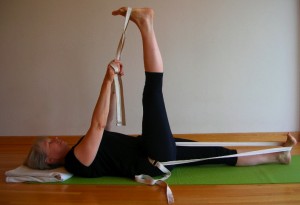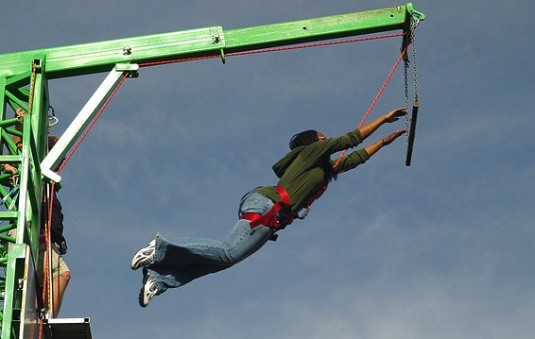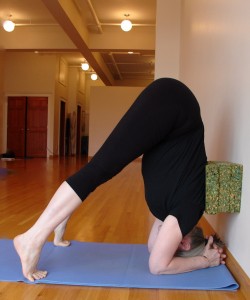JoAnn came to her private yoga class last week with a copy of “Father William,” Lewis Carroll’s poem in which an obnoxious young man attempts to guide his father in age-appropriate behavior.
“Do you know it?” she asked.
Do I know it? My mother loved it, and often quoted the first lines. I’ve used it on this blog. I don’t need to see it to start reciting:
“You are old father William,” the young man said,
“And your hair has become very white.
“And yet you consistently stand on your head,
“Do you think at your age that is right?”
JoAnn is 69. She wants to be to be able to say: “I learned headstand when I was 70.”
Her questions: Did I think at her age that is right? And would I help?
My answer? Of course – on both counts!
This is the kind of challenge I adore. The goal is exciting. The timeline is as long as it takes, but as soon as possible. And the protagonist is a steady student, good humored and hardworking, with none of the contraindications for headstand (high blood pressure, neck pain, glaucoma or other eye problems).
Lewis Carroll’s verse ends:
“In my youth,” the father replied to his son,
“I feared it might injure the brain.
“But now I am perfectly sure I have none,
“So I do it again, and again.”
But I think it’s precisely because we have brains that headstand grows in importance as we age.
After all, who couldn’t use a little more energy, concentration and mental clarity?
And there’s an excellent precedent. B.K.S. Iyengar taught headstand to the Elisabeth, Queen of Belgium, when she was 80, although, in his telling, she commanded him to do it.
To begin, we focused on three basic elements for getting into a good headstand: strong, active legs with flexible hamstrings, strong abdominals, and strong, open shoulders.
•Downward dog will help with all three.
Supta Padangusthasana 1: with the correct leg actions, it will connect and strengthen your core as it lengthens your hamstrings.
• The first variation of lying down big toe pose (Supta Padangusthasana) will loosen hamstrings and increase core strength and awareness. This one shows a strap at the groin, but you’ll get the idea, and the actions.
• Prasarita Padottanasana, the wide-legged standing forward bend, gets us used to having the head down and sets up the essential action of headstand through the shoulders: they lift away from the ears.
We also looked at the classic headstand preparation with the hands clasped, elbows in line, head on the floor and pelvis lifted, feet walking in.
But that preparation is harder to hold than the full pose – which is why most yoga students, myself included, are tempted to sail past it as quickly as we can.
If this is your main preparation for headstand, you’re likely to feel that the pose itself is beyond your reach. As useful as it may be for increasing strength, it doesn’t provide something equally important – a firm platform for a leap of faith.
Given the basic uncertainty of life, I’m sure as I can be that JoAnn will one day place her knuckles at a wall and kick up into a headstand with lifted shoulders, a long lower back and active legs, and then take her heels away from the wall and balance.
To do that will require a leap of faith.
No one ever kicked up into headstand for the first time, even with a wall behind them, without having to jump past the primal fear of falling over backwards.
What we need is a preparation that allows us to experience how headstand, or at least a pose very much like it, could be easy, and could make us feel powerful.
The best one I know is this headstand preparation with support for the back. (Click on the link for the full instructions.)
I learned it in a long-ago workshop with Aadil Palkhivala. As he pointed out at the time, it gives the same head-clearing sensation as a full headstand.
It also allows us to see how pressing down into the forearms lifts the upper arms and shoulders away from the floor.
It gives us the sensation of walking in to kick up without the heaviness of the unsupported preparation.
In that lightness, we can learn to press the upper front thighs back and lift the pelvis even more.
Yes, when it’s time to kick away from the floor for the first time, we all need to take a leap of faith to get where we want to go.
But with this work set in body and mind, we’ll have built ourselves a great place to push off from.
Photo courtesy Diego Hurtado, via Flickr
If this was your kind of post you might also like:
Give me strength: a tale of three headstands
Are some yoga poses lemons?
Life, Happiness and the Pursuit of Liberty?






Comments on this entry are closed.
What a wonderful and inspiring story. Yoga is so beneficial to person’s of ANY age and it is so fantastic to see so many different generations, both old and young, really taking advantage of the wonderful benefits associated with yogic practice. Great post, and thank you for sharing!
Timely post! I have students in the same boat. Here, you distill the essential elements (flexible hamstrings, strong abs, etc), plus the leap of faith. What about students with tight hamstrings that preclude their walking in toward a perpendicular torso? Do you assess their upper back/chest/shoulders upright (since they are bound to appear rounded upside down, due to hamstring restriction)?
I’ll try the Aadil prep later today. It must require even more energy than the frame of wood blocks often used (since you must hold them up). Iyengar yoga is never boring!
Hey Yoga Spy,
Good to hear from you! True, Iyengar yoga is never boring.
In Aadil’s preparation at least, when the hamstrings are tight, I let them bend their knees – and it also helps that the feet are as wide as the mat. That way most people can be perpendicular. I wouldn’t say it’s harder than the four-bricks preparation – it’s your weight that holds the bricks at the wall. You’ll see when you try it.
Greetings Eve!
Love your posts and the 5minute yoga philosophy! Cultivating a home practice even of five minutes is so doable and easy for the average person to discover the enormous benefits of yoga. I also teach and you are an inspiration. I often share your postings. This one is wonderful and inspiring!
Namaste!
Hi Mary,
So glad you enjoy the blog. Thanks so much for your comment.